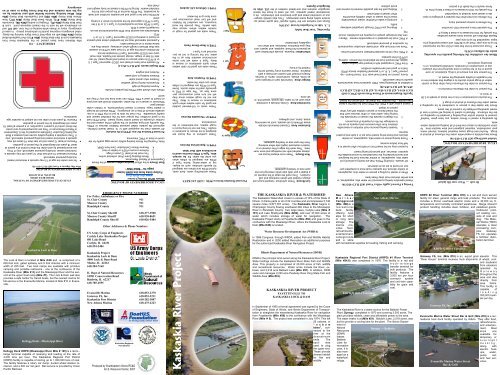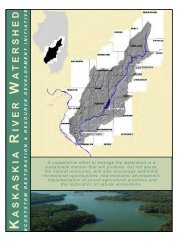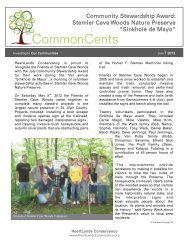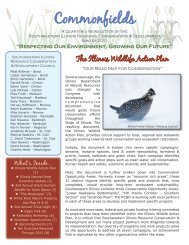Kaskaskia River Project 911 Map - HeartLands Conservancy
Kaskaskia River Project 911 Map - HeartLands Conservancy
Kaskaskia River Project 911 Map - HeartLands Conservancy
You also want an ePaper? Increase the reach of your titles
YUMPU automatically turns print PDFs into web optimized ePapers that Google loves.
Be safe …. Wear your life jacket!<br />
LEGAL REQUIREMENTS OF BOATING<br />
Alcohol and Drugs (625 ILCS 45/5-16)<br />
Illinois law prohibits a vessel while under the influence of alcohol or<br />
drugs. Alcohol and drugs cause impaired balance, blurred vision,<br />
poor coordination, impaired judgment and slow reaction time. Alcohol<br />
contributes to about one-third of all boating accidents nationwide.<br />
By operating a vessel in Illinois’ waters, you have given “implied”<br />
consent to alcohol and/or drug testing if arrested for operating under<br />
the influence. Refusal to submit to testing will result in loss of<br />
vessel operating privileges for a period of two years.<br />
Illinois law states that a person is considered to be operating a<br />
vessel under the influence of alcohol or drugs if:<br />
• The alcohol concentration in his or her blood or breath is 0.08<br />
or more or…<br />
• The person is under the influence of alcohol or…<br />
• The person is under the influence of any other drug or combination<br />
of drugs and/or alcohol to a degree that renders him or<br />
her incapable of safety operating the vessel or…<br />
• The person has any amount of a drug, substance, or compound<br />
in his or her blood or urine resulting from the unlawful<br />
use or consumption of cannabis, controlled substance, or intoxicating<br />
compound...<br />
Illinois law establishes the following penalties for operating<br />
under the influence (OUI):<br />
• Those convicted for the first time of OUI may be imprisoned<br />
for up to one year, fined up to $2,500, and vessel operating privileges<br />
suspended for up to one year.<br />
Repeat offenders will receive more severe penalties.<br />
The penalty for OUI increases to a class 4 felony if:<br />
• The operator has a previous OUI conviction.<br />
• The offense is serious personal injury.<br />
• The offense occurred when the operator’s privileges to operate<br />
a vessel were revoked or suspended.<br />
• The penalty for OUI increases to a Class 2 felony if the offense<br />
results in the death of a person.<br />
Towing a Person Legally with a Vessel (625 ILCS 45/5/14)<br />
Vessel operators towing a person(s) on water skis, aquaplanes, or<br />
any similar devices must obey these laws:<br />
• When a vessel is pulling a person on water skis, aquaplanes,<br />
or similar devices, the operator must have a competent person<br />
on board to act as an observer.<br />
• All vessels, including PWCs, that are towing a person(s) on<br />
water skis, aquaplanes, or similar devices must be designed<br />
and recommended by the manufacturer to accommodate the<br />
operator, observer, and person(s) being towed.<br />
• A person may not be towed from a half-hour after sunset to a<br />
half-hour before sunrise.<br />
• Those towing skiers on water-skis, aquaplanes, or similar<br />
devices and those being towed must act in a safe and prudent<br />
manner.<br />
◊ Vessels towing persons must maintain a reasonable<br />
distance from other persons and property so as not<br />
to endanger the life or property of any person.<br />
◊ It is illegal to operate the vessel or manipulate the<br />
towing rope, water skis, or other devices such that<br />
the towed device or person collides with any other<br />
person or object.<br />
If towing a skier with a PWC, the PWC must be rated for a least<br />
three people – the operator, the observer, and person be towed.<br />
Specific Requirements of Person Watercraft (PWCs) (625<br />
ILCS 45/4-1, 625 ILCS 45/4-11, 625 ILCS 45/5.2, 625 ILCS<br />
45/5-18, 625 ILCS 45/5-20)<br />
In addition to all boating laws, PWC operators have requirements<br />
specific to their watercraft:<br />
• Every person on board must wear U.S. Coast Guard – approved<br />
Type I, II, III, or V personal floatation device (PFD)<br />
that is in good and serviceable condition.<br />
• If the PWC is equipped with a lanyard-type ignition safety<br />
switch, the lanyard must be attached to the person, clothing,<br />
or PFD of the operator.<br />
• A PWC may not be operated between sunset and sunrise.<br />
• There are minimum age and boater education requirements<br />
for operators of personal watercraft.<br />
• A PWC must be operated in a responsible manner. Maneuvers<br />
that endanger people or property are prohibited, including:<br />
◊ Weaving your PWC through congested waterway<br />
traffic.<br />
◊ Jumping a wake of another vessel unreasonably<br />
close to the vessel or when visibility around the<br />
other vessel is obstructed.<br />
◊ Waiting until the last possible moment to swerve and<br />
avoid collision<br />
Operating Your Boat Safely<br />
Can Buoys: These cylindrical –shaped buoys are<br />
always marked with green markings and odd<br />
numbers. They mark the edge of the channel on<br />
a boater’s port (left) side when entering from the<br />
open sea or heading upstream.<br />
Nun Buoys: These cone-shaped buoys are<br />
always marked with red markings and even numbers.<br />
They mark the edge of the channel on a<br />
boater’s starboard (right) side when entering<br />
from the open sea or heading upstream.<br />
Exclusion Area: Crossed diamonds indicate<br />
areas off-limits to all vessels, such as swimming<br />
areas, dams, and spillways.<br />
Controlled Area: Circles indicate a controlled<br />
area such as no wake, idle speed, speed limit, or<br />
ski zone.<br />
Danger Area: Diamonds warn of dangers such<br />
as rocks, shoals, construction, dams, or stumps.<br />
Always proceed with caution and keep a safe<br />
distance. Never assume every hazard will be<br />
marked by a buoy.<br />
Information: Squares provide information such<br />
as places to find food, supplies, and repairs; and<br />
they give directions, distances, and other nonregulatory<br />
information.<br />
U. S. Aids to Navigation System (ATON)<br />
Buoys and markers are the “traffic signals” that guide vessel operators<br />
safely along some waterways. They also identify dangerous<br />
or controlled areas and give directions and information. As a<br />
recreational vessel operator, you will need to know the lateral<br />
navigation markers and non-lateral markers of the U.S. Aids to<br />
Navigation System.<br />
Personal Flotation Devices (PFD) : LIFE JACKETS<br />
These windsurfing vests, deck suits,<br />
hybrid PFDs and others are designed<br />
for specific activities, such as kayaking<br />
or water-skiing. Some Type V<br />
PFDs are designed to inflate when<br />
you enter the water. To be acceptable,<br />
Type V PFDs must be used in<br />
accordance with their label.<br />
TYPE V: Special-Use Devices<br />
These cushions or ring buoys are<br />
designed to be thrown to someone in<br />
trouble. They are not for long hours in<br />
rough waters, non-swimmers or the<br />
unconscious.<br />
TYPE IV: Throwable Devices<br />
These vests or full-sleeved jackets<br />
are good for calm waters when quick<br />
assistance or rescue is likely. They<br />
are not for rough waters since they<br />
will not turn most unconscious persons<br />
face up. This type of PFD is<br />
generally used for water sports. Some<br />
Type III PFDs are designed to inflate<br />
when you enter the water.<br />
TYPE III: Flotation Aids<br />
These vests are good for calm waters<br />
when quick assistance or rescue is<br />
likely. Type II vests will turn some<br />
unconscious wearers face up in the<br />
water, but the turning is not as pronounced<br />
as a Type I.<br />
TYPE II: Near-Shore Vests<br />
These vests are geared for rough or<br />
remote waters where rescue may<br />
take awhile. They provide the most<br />
buoyancy, are excellent for flotation<br />
and will turn most unconscious persons<br />
face up in the water.<br />
TYPE I: Offshore Life Jackets<br />
LEGAL REQUIREMENTS OF BOATING<br />
Illinois IDNR Boating License<br />
www.dnr.state.il.us<br />
Follow links from the IDNR homepage<br />
for “BOATING”.<br />
Boat Illinois is the official boating safety course of the Illinois<br />
Department of Natural Resources.<br />
1. Illinois Boating Exam (Fee) collected online.<br />
2. You must be at least 12 years of age.<br />
3. Achieve a score of 80% or better on test.<br />
4. Receive Illinois Certification Card from IDNR.<br />
Note: Passing the Illinois boating safety course may qualify for discount<br />
on boat or PWC insurance.<br />
Personal Flotation Devices (PFD) (Life Jackets)<br />
All vessels must be equipped with U. S. Coast Guard (USCG)–<br />
approved life jackets called personal flotation devices or PFDs.<br />
The quantity and type depend on the length of the vessel and the<br />
number of people on board and/or being towed. Each PFD must<br />
be in good condition, the proper size for the intended wearer and<br />
readily accessible. You must be able to put on the PFD in a reasonable<br />
amount of time in an emergency. PFDs should not be kept<br />
in plastic bags, locked in closed compartments, or hidden under<br />
stowed gear.<br />
Whenever a vessel is on the water, operators should ask everyone<br />
on board to wear a PFD. PFDs can save lives but only if they are<br />
worn!<br />
Others who should wear PFDs (life jackets) include:<br />
• Anyone boating at night<br />
• All persons during rough weather<br />
• Persons who cannot swim<br />
• Persons boating in cold water<br />
• Hunters and anglers<br />
PFD Requirements (625 ILCS 45/4-1)<br />
• All vessels must have at least one USCG–approved Type I, II,<br />
or III PFD for each person on board and being towed. All vessels<br />
16 feet or longer, except canoes and kayaks, also must<br />
carry one USCG–approved Type IV throwable device.<br />
• All children under the age of 13 must wear a PFD on vessels<br />
less than 26 feet in length when underway, unless they are<br />
below decks in an enclosed cabin.<br />
• A personal watercraft may not be operated unless each person<br />
on board is wearing a USCG–approved Type I, II, III, or V<br />
PFD.<br />
• Sailboarders are exempt from PFD requirements but are encouraged<br />
to wear a PFD.<br />
• Type V PFDs may be substituted for a Type I, II, or III if the<br />
Type V PFD is approved for the activity for which it is being<br />
used.<br />
• All PFDs must be in good and serviceable condition and readily<br />
accessible. The PFDs must be of the proper size for the<br />
intended wearer. Sizing for PFDs is based on body weight and<br />
chest size.<br />
STATE OF ILLINOIS DEPARTMENT OF NATURAL<br />
RESOURCES (IDNR)<br />
BOATING IN ILLINOIS<br />
LEGAL REQUIREMENTS OF BOATING<br />
Who May Operate a Vessel (625 ILCS 45/5-18)<br />
• No one under the age of 10 may operate a motorized vessel,<br />
including personal watercraft.<br />
• Persons between 10 and less than 12 years old may operate a<br />
motorized vessel, including personal watercraft, only if: They<br />
are accompanied by and under the direct control of a parent at<br />
least 18 years old designated by the parent or guardian.<br />
• Persons at least 12 years old but less than 18 years old may<br />
operate a motorized vessel including personal watercraft, only<br />
if: They complete a boating safety course and possess a Boating<br />
Safety Education Certificate accepted by the IL Department<br />
of Natural Resources or They are accompanied by and under<br />
the direct control of a parent, a guardian, or a person at least 18<br />
years old designated by the parent or guardian.<br />
• Persons 18 years old or older are not subject to operator age<br />
restrictions.<br />
EMERGENCY - <strong>911</strong><br />
Mile Markers have been placed on the <strong>Kaskaskia</strong> <strong>River</strong> from<br />
<strong>Kaskaskia</strong> Lock & Dam Boat Ramp (Mile #1) to the Fayetteville Boat<br />
Ramp (Mile #36) with six large Red Cross Signs marking the designated<br />
emergency response points for ambulance pickup. In case of<br />
emergency, injury or illness while boating on the river, call <strong>911</strong> and<br />
an ambulance will be sent to the closest response point: Lock &<br />
Dam Boat Ramp (Mile #1), Phegley’s Landing (Mile #6), Evansville<br />
Boat Ramp (Mile #11), White Swan Boat Ramp (Mile #17), New<br />
Athens Boat Ramp (Mile #28) and Fayetteville Boat Ramp (Mile<br />
#36). When boating, become familiar with your location by using<br />
the mile markers and the Red Cross Signs in case of an<br />
emergency.<br />
<strong>Kaskaskia</strong> Lock & Dam<br />
The Lock & Dam is located at Mile #.08 and is comprised of a<br />
600-foot lock, gated spillway and 9 foot channel with a minimum<br />
width of 225 feet. Two boat ramps are available with primitive<br />
camping and portable restrooms - one at the confluence of the<br />
<strong>Kaskaskia</strong> <strong>River</strong> (Mile # 0) and the Mississippi <strong>River</strong> and the second<br />
at the upper boat ramp (Mile #1). The Lock & Dam wall also<br />
provides a safe harbor for transit boats, but the nearest marina for<br />
full-service is the Evansville Marina, located at Mile #10 in Evansville.<br />
Kellogg Dock—Mississippi <strong>River</strong><br />
Kellogg Dock KRPD (Mississippi <strong>River</strong> Mile # 125) is a rail-to -<br />
barge terminal capable of receiving and loading at the rate of<br />
4,000 tons per hour. The <strong>Kaskaskia</strong> Regional Port District<br />
(KRPD) facility is capable of storing up to 1,000,000 tons of coal.<br />
The facility features a rotary car dump, bucket wheel stacker reclaimer,<br />
and a 300 car rail yard. Rail service is provided by Union<br />
Pacific Railroad.<br />
EMERGENCY PHONE NUMBERS<br />
For Police Ambulance or Fire<br />
St. Clair County <strong>911</strong><br />
Monroe County <strong>911</strong><br />
Randolph County <strong>911</strong><br />
St. Clair County Sheriff 618-277-3500<br />
Monroe County Sheriff 618-938-8651<br />
Randolph County Sheriff 618-826-5484<br />
Other Addresses & Phone Numbers<br />
US Army Corps of Engineers<br />
Carlyle Lake /<strong>Kaskaskia</strong> <strong>Project</strong><br />
801 Lake Road<br />
Carlyle, IL 62231<br />
618-594-2484<br />
<strong>Kaskaskia</strong> <strong>Project</strong><br />
<strong>Kaskaskia</strong> Lock & Dam<br />
4800 Lock & Dam Road<br />
Modoc, IL 62261<br />
618-284-7160<br />
IL Dept of Natural Resources<br />
10981 Conservation Road<br />
Baldwin, IL 62217<br />
618-785-2555<br />
Evansville Marina 618-853-2370<br />
Gateway FS, Inc. 618-853-2211<br />
<strong>Kaskaskia</strong> Port District 618-282-3807<br />
New Athens Marina 618-475-2223<br />
<strong>Kaskaskia</strong> Regional<br />
Port District<br />
Produced by Southwestern Illinois RC&D<br />
G.I.S. Resource Center, 2007<br />
<strong>Kaskaskia</strong> <strong>River</strong> <strong>Project</strong><br />
THE KASKASKIA RIVER & WATERSHED<br />
The <strong>Kaskaskia</strong> Watershed covers in excess of 10% of the State of<br />
Illinois. It drains parts or all of 22 counties and encompasses 5,746<br />
square miles (3,677,787 acres). The <strong>Kaskaskia</strong> <strong>River</strong> begins in<br />
Champaign County flowing southwest 292 miles to the Mississippi<br />
<strong>River</strong> in Randolph County. Two large lakes, Carlyle Lake (Mile #<br />
101) and Lake Shelbyville (Mile #222), add over 37,000 acres of<br />
water which includes storage of water for navigation. The<br />
<strong>Kaskaskia</strong> <strong>Project</strong> starts at Fayetteville (Mile #36) and goes to the<br />
confluence with the Mississippi <strong>River</strong>, where the <strong>Kaskaskia</strong> Lock &<br />
Dam (Mile #.08) is located.<br />
Water Resource Development Act (WRDA)<br />
In 1996 Congress, through WRDA, added Fish and Wildlife Habitat<br />
Restoration and in 2000 added Recreation as additional purposes<br />
for the authorized <strong>Kaskaskia</strong> <strong>River</strong> Navigation <strong>Project</strong>.<br />
Illinois Department of Natural Resources (IDNR)<br />
IDNR is the principal land owner along the <strong>Kaskaskia</strong> <strong>River</strong> <strong>Project</strong>.<br />
State holdings include the <strong>Kaskaskia</strong> <strong>River</strong> State Fish and Wildlife<br />
Area. This property is comprised of 20,000 acres of fish, wildlife<br />
and recreational resources. Water acres include the <strong>River</strong>, oxbows,<br />
and 2,018 acre Baldwin Lake (Mile #21). In addition, IDNR<br />
owns and manages 2,220 acre Peabody <strong>River</strong> King State Fish and<br />
Wildlife Area (Mile #33).<br />
KASKASKIA RIVER PROJECT<br />
FAYETTEVILLE TO<br />
KASKASKIA LOCK & DAM<br />
In September of 1965 a formal agreement was signed by the Corps<br />
of Engineers, State of Illinois, and Illinois Department of Transportation<br />
to straighten the meandering <strong>Kaskaskia</strong> <strong>River</strong> for navigation<br />
from Fayetteville (Mile #36) to the confluence with the Mississippi<br />
<strong>River</strong> (Mile # 0). The project was completed in July 1974. This left<br />
26 oxbows, or<br />
“ o x b o w<br />
lakes”, connected<br />
to the<br />
river at the<br />
downstream<br />
ends. The<br />
Oxbow<br />
Remnant<br />
spoil was<br />
used to plug<br />
the upper end.<br />
These provide<br />
diverse habitat<br />
for fish and<br />
wildlife.<br />
New Athens<br />
M a r i n a /<br />
New Athens Marina<br />
Campground<br />
(Mile #28) is a<br />
recreational<br />
dock facility<br />
offering boat<br />
slips for short<br />
or long term<br />
storage. The<br />
marina provides<br />
food,<br />
refreshments,<br />
entertainment,<br />
campgrounds<br />
and a store<br />
with recreational supplies for boating, fishing and camping.<br />
<strong>Kaskaskia</strong> Regional Port District (KRPD) #1 <strong>River</strong> Terminal<br />
(Mile #24.8) was completed in 1976. The facility is a rail and<br />
truck-to-barge<br />
transfer terminal for<br />
bulk products. The<br />
facility features a<br />
3,000 ton per hour<br />
conveyor system<br />
and unit train capability<br />
for grain and<br />
coal.<br />
KRPD #1 <strong>River</strong> Terminal<br />
The <strong>Kaskaskia</strong> <strong>River</strong> is a water source for the Baldwin Power<br />
Plant, Dynegy, completed in 1970 and covering 3,000 acres. The<br />
plant provides reliable, clean and affordable power to the area.<br />
The water intake is at (Mile #21). Baldwin Lake, 2,018 acres, was<br />
built to provide a cooling lake for the plant. The Illinois Department<br />
of<br />
Natural<br />
Dynegy — Baldwin<br />
Resources<br />
(IDNR)<br />
leases<br />
Baldwin<br />
Lake for<br />
recreation<br />
uses. It is<br />
also managed<br />
as a<br />
waterfowl<br />
refuge.<br />
KRPD #2 <strong>River</strong> Terminal (Mile #19) is a rail and truck served<br />
facility for steel, general cargo and bulk products. The terminal<br />
includes a 50-ton overhead electric crane and a 30,000 sq. ft.<br />
temperature and humidity controlled warehouse. Barge inbound<br />
product handling includes steel, fertilizer, and palletized goods.<br />
Outbound product<br />
loading consists<br />
of coal and<br />
slag. The Material<br />
Works (TMW)<br />
operates a steel<br />
processing complex.<br />
Gateway<br />
FS, Inc. operates<br />
a fertilizer distribution<br />
terminal.<br />
KRPD #2 <strong>River</strong> Terminal<br />
Gateway FS, Inc. (Mile #10) is an export grain elevator. This<br />
“<strong>River</strong> House” terminal receives truck shipments of wheat, corn,<br />
and soybeans<br />
from elevators<br />
operated by<br />
Gateway<br />
throughout the<br />
area and also<br />
directly from<br />
area farms.<br />
This facility is<br />
capable of<br />
l o a d i n g<br />
350,000 bushels<br />
per day.<br />
Gateway FS, Inc. - Evansville<br />
Evansville Marina Water Street Bar & Grill (Mile #10) is a recreational<br />
boat dock facility operated by Adkris. They offer food,<br />
refreshments,<br />
and entertainment.<br />
Boat<br />
slips are<br />
available for<br />
temporary or<br />
overnight<br />
docking,<br />
along with<br />
electric hook<br />
ups, water,<br />
Evansville Marina Water Street<br />
Bar & Grill<br />
pump out,<br />
and fuel services.







